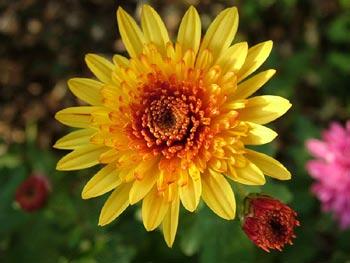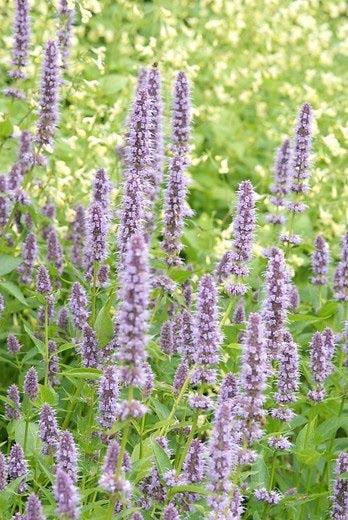
4 minute read
TIPStricks
Chrysanthemums contain a natural insect repellent called pyrethrum. Researchers are studying ways to increase production of the flowerheads, which contain the most pyrethrum. Credit: Morguefile.
Where Does Natural Pyrethrum Come From?
Unless you enjoy getting bitten by mosquitoes, you’ve probably used insect repellent once or twice in your life. While we use cans full of chemicals, flowers have their own natural way of preventing pests. You may have heard of the common trick of planting chrysanthemums around your garden to deter pests. Marigolds work, too. This is because these flowers are naturally are high in chemical compounds that insects don’t like. A particular type of chrysanthemum, Chrysanthemum cinerariifolium, isn’t typically found in nurseries. Its flowers are very high in the natural compound pyrethrum. It can be used as both a natural pesticide on organic farms and an insect repellent for humans. As such, it’s been called a “green pesticide” and researchers are looking at ways to make more of it. The use of pyrethrum as an insecticide was a well-kept secret by ancient Persians, for the health of their crops, but its use is documented from around 400 BC. Japan was the leading producer of pyrethrum before World War II, and later, African countries began production. Pyrethrum can repel insects like mosquitoes and ticks. It can be used in dog shampoos (if dosed just right), but not cat shampoos because it’s toxic to cats. How can planting chrysanthemums around your garden protect it? Plants have glands, called trichomes, and some plants secrete a chemical compound from these glands, in this case, pyrethrum. It is not the most-pleasant scent. In the case of Chrysanthemum cinerariifolium, the highest concentration of pyrethrum is in its flowers, which are the focus of the harvest. Growers harvest the flowers at specific stages and dry the flowers. They then grind the flowers and extract the pyrethrum. From there, different products can be made, such as powders and liquids. In its natural state, Chrysanthemum cinerariifolium doesn’t flower until its second year of growth. Researchers at the University of Minnesota recently published a paper about the work to breed a new type of pyrethrum that can flower in its first year. This would greatly increase the yield for growers. They were also looking for varieties that grow more flowers and less of the leaves and stalks, which don’t contain as much pyrethrum. After their initial research using seeds collected from various sources, they will continue their studies and breeding in hopes of create a higher-yielding, first-year flower producer that makes more natural pyrethrum.
Natural Pyrethrum vs. Synthetic Pyrethrin
Note that pyrethrum is the natural compound found in daisies, and Chrysanthemum cinerariifolium is the type of daisy that contains the most and is used commercially. The compound can also be made in the lab and factories (referred to as synthetic). In this case, it is referred to as pyrethrin and often mixed with other chemicals to enhance their effects. Permethrin is a synthetic compound based on the chemical structure of the natural pyrethrum. It is used to treat clothing, tents, and outdoor equipment, not skin. Watch for these different spellings in the name when you make a purchase. As always, read label directions before using any pesticide or bug spray. This research was compiled by Susan Fisk, from research published in Crop Science, a journal of the Crop Science Society of America for the Sustainable, Secure Food blog at sustainable-securefood-blog.com. For more information, visit sciencesocieties.org. o

Attracting Butterflies with Nectar Plants
Nectar plants serve as magnets for butterflies. Nectar is the sweet, syrupy liquid produced by the nectary glands in flowers. Butterflies simply can’t resist it, and while a butterfly flutters happily from flower to flower, it also pollinates the flowers in your garden. The quantity of nectar in a flower varies from one plant species to another and even among varieties or cultivars of a single species. Many species of summer-flowering perennials are good sources of nectar. These include plants like Purple Coneflower (Echinacea purpurea), Purpletop Vervain (Verbena bonariensis), and Giant Hyssop (Agastache). In some flowers, you can actually see the nectar, either in the center of the flower or on its outer surface. It may look like water, but touching it reveals its stickiness. In addition to its sugars, nectar also contains proteins and vitamins that most female butterflies need to produce their eggs. Many nectar plants that attract butterflies will also attract bumblebees and other bees. Butterflies, however, have one advantage over the bees: a long proboscis that allows them to reach the nectar in tubular flowers that many bees and bumblebees can’t reach as well with their shorter tongues. For more information about perennial plants that make good nectar sources, visit www.perennialpower.eu. o










